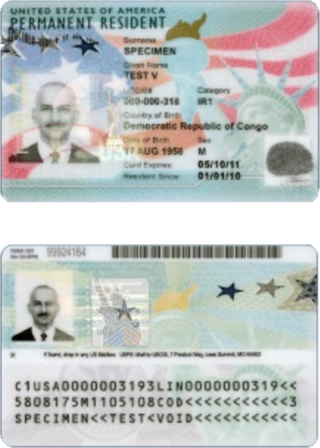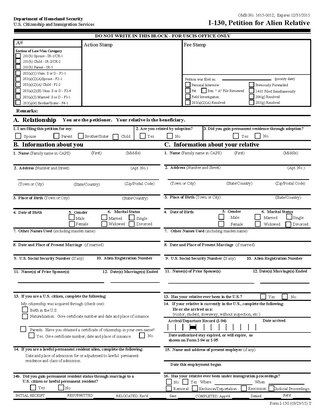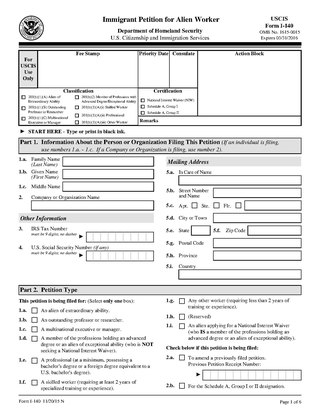Related Research Articles

A green card, known officially as a permanent resident card, is an identity document which shows that a person has permanent residency in the United States. Green card holders are formally known as lawful permanent residents (LPRs). As of 2019, there are an estimated 13.9 million green card holders, of whom 9.1 million are eligible to become United States citizens. Approximately 65,000 of them serve in the U.S. Armed Forces.
The H-1B is a visa in the United States under the Immigration and Nationality Act, section 101(a)(15)(H) that allows U.S. employers to employ foreign workers in specialty occupations. A specialty occupation requires the application of specialized knowledge and a bachelor's degree or the equivalent of work experience. The duration of stay is three years, extendable to six years, after which the visa holder may need to reapply. Laws limit the number of H-1B visas that are issued each year: 188,100 new and initial H-1B visas were issued in 2019. Employers must generally withhold Social Security and Medicare taxes from the wages paid to employees in H-1B status.
An L-1 visa is a visa document used to enter the United States for the purpose of work in L-1 status. It is a non-immigrant visa, and is valid for a relatively short amount of time, from three months to five years, based on a reciprocity schedule. With extensions, the maximum stay is seven years.
An Application for Waiver of Grounds of Inadmissibility is an application for legal entry to the United States made by an individual who is otherwise inadmissible on one or more grounds. The application is submitted to the consular office, U.S. Citizenship and Immigration Services office or immigration court considering the immigrant visa or adjustment of status application.
A K-1 visa is a visa issued to the fiancé or fiancée of a United States citizen to enter the United States. A K-1 visa requires a foreigner to marry his or her U.S. citizen petitioner within 90 days of entry, or depart the United States. Once the couple marries, the foreign citizen can adjust status to become a lawful permanent resident of the United States. Although a K-1 visa is legally classified as a non-immigrant visa, it usually leads to important immigration benefits and is therefore often processed by the Immigrant Visa section of United States embassies and consulates worldwide.
U.S. Citizenship and Immigration Services (USCIS) is an agency of the United States Department of Homeland Security (DHS) that administers the country's naturalization and immigration system. It is a successor to the Immigration and Naturalization Service (INS), which was dissolved by the Homeland Security Act of 2002 and replaced by three components within the DHS: USCIS, Immigration and Customs Enforcement (ICE), and Customs and Border Protection (CBP).
The V visa is a temporary visa available to spouses and minor children of U.S. lawful permanent residents. It allows permanent residents to achieve family unity with their spouses and children while the immigration process takes its course. It was created by the Legal Immigration Family Equity Act of 2000. The Act is to relieve those who applied for immigrant visas on or before December 21, 2000. Practically, the V visa is currently not available to spouses and minor children of LPRs who have applied after December 21, 2000.

The visa policy of the United States consists of the requirements for foreign nationals to travel to, enter, and remain in the United States. Visitors to the United States must obtain a visa from one of the U.S. diplomatic missions unless they come from one of the visa-exempt or Visa Waiver Program countries. The same rules apply for travel to all U.S. states, Washington, D.C., Puerto Rico and the U.S. Virgin Islands, as well as to Guam and the Northern Mariana Islands with additional waivers, while similar but separate rules apply to American Samoa.
Permanent Residence Under Color of Law (PRUCOL) is an immigration-related status used under some US federal and state laws for determining eligibility for some public benefits, an example being unemployment benefits. It allows for a broader group of non-citizens to qualify for benefits than just those with green cards. This status is used solely for benefit application purposes and is not recognized as an immigration status by the U.S. Citizenship and Immigration Services (USCIS). This category was created by the courts and is a public benefits eligibility category. For a person to be residing "under color of law," the USCIS must know of the person’s presence in the U.S., and must provide the person with written assurance that enforcement of deportation is not planned. A person residing under PRUCOL status cannot directly apply for U.S. citizenship or sponsor family members to obtain U.S. Citizenship. A person from any country, who resides in the United States without current legal immigration status including, but not limited to, citizenship, permanent residency, unexpired immigrant visa, is an undocumented person. They are ineligible for most federal public benefits.
The Security Through Regularized Immigration and a Vibrant Economy Act of 2007 or STRIVE Act of 2007 is proposed United States legislation designed to address the problem of illegal immigration, introduced into the United States House of Representatives. Its supporters claim it would toughen border security, increase enforcement of and criminal penalties for illegal immigration, and establish an employment verification system to identify illegal aliens working in the United States. It would also establish new programs for both illegal aliens and new immigrant workers to achieve legal citizenship. Critics allege that the bill would turn law enforcement agencies into social welfare agencies as it would not allow CBP to detain illegal immigrants that are eligible for Z-visas and would grant amnesty to millions of illegal aliens with very few restrictions.
Family reunification is a recognized reason for immigration in many countries because of the presence of one or more family members in a certain country, therefore, enables the rest of the divided family or only specific members of the family to emigrate to that country as well.

The Cuban Adjustment Act, Public Law 89-732, is a United States federal law enacted on November 2, 1966. Passed by the 89th United States Congress and signed into law by President Lyndon Johnson, the law applies to any native or citizen of Cuba who has been inspected and admitted or paroled into the United States after January 1, 1959 and has been physically present for at least one year, and is admissible to the United States as a permanent resident.
The International Marriage Broker Regulation Act of 2005, or IMBRA, codified at , is a United States federal statute that requires background checks for all marriage visa sponsors and limits serial visa applications. Additionally, the law requires background checks for US citizens using marriage brokerage services focused primarily on providing dating services between US citizens or residents and foreign nationals for a fee. The impetus for its introduction were the Susanna Blackwell case in 1995 and the Anastasia King case in 2000, in which foreign women had been abused and murdered by men who had used a K-1 fiancée visa issued by the U.S. State Department to bring them to the United States. In the King case, the husband had physically abused a previous foreign bride before murdering Anastasia. King had met Anastasia through his own advertisement in a Moscow newspaper. In the Blackwell case, the husband had a clean record, therefore IMBRA would not have prevented her murder. It was intended to stop abuse of mail order brides by prospective husbands with criminal histories. IMBRA met with opposition from international dating companies when it was first introduced. Some industry executives claim the industry has grown to appreciate it to ensure the safety of its female clients.
Alien of extraordinary ability is an alien classification by United States Citizenship and Immigration Services. The United States may grant a priority visa to an alien who is able to demonstrate "extraordinary ability in the sciences, arts, education, business, or athletics" or through some other extraordinary career achievements.

The Border Security, Economic Opportunity, and Immigration Modernization Act of 2013 was a proposed immigration reform bill introduced by Sen. Charles Schumer (D-NY) in the United States Senate. The bill was co-sponsored by the other seven members of the "Gang of Eight", a bipartisan group of U.S. Senators who wrote and negotiated the bill. It was introduced in the Senate on April 16, 2013 during the 113th United States Congress.
The United States Citizenship and Immigration Services (USCIS) issues a number of forms for people to submit to them relating to immigrant and non-immigrant visa statuses. These forms begin with the letter "I". None of the forms directly grants a United States visa, but approval of these forms may provide authorization for staying or extending one's stay in the United States as well as authorization for work. Some United States visas require an associated approved USCIS immigration form to be submitted as part of the application.

Form I-130, Petition for Alien Relative is a form submitted to the United States Citizenship and Immigration Services by a United States citizen or Lawful Permanent Resident petitioning for an immediate or close relative intending to immigrate to the United States. It is one of numerous USCIS immigration forms. As with all USCIS petitions, the person who submits the petition is called the petitioner and the relative on whose behalf the petition is made is called the beneficiary. The USCIS officer who evaluates the petition is called the adjudicator.
The National Visa Center (NVC) is a center that is part of the U.S. Department of State that plays the role of holding United States immigrant visa petitions approved by the United States Citizenship and Immigration Services until an immigrant visa number becomes available for the petition, at which point it arranges for the visa applicant(s) to take the visa interview at a consulate abroad. It is located in Portsmouth, New Hampshire. It was established on July 26, 1994, on the site of an Air Force base that was closed down by The Pentagon.
The Legal Immigration Family Equity Act of 2000, also known as the LIFE Act and as the Legal Immigration and Family Equity Act, along with its Amendments, made some changes to laws surrounding immigration for family members of United States citizens and Lawful Permanent Residents, as well as people eligible for employment-based immigrant visas, in the direction of making it easier for family members and immigrant workers to move to and adjust status within the United States. It was passed on December 21, 2000, as title XI of Pub. L. 106–553 (text)(PDF).

Form I-140, Immigrant Petition for Alien Worker is a form submitted to the United States Citizenship and Immigration Service (USCIS) by a prospective employer to petition an alien to work in the US on a permanent basis. This is done in the case when the worker is deemed extraordinary in some sense or when qualified workers do not exist in the US. The employer who files is called the petitioner, and the alien employee is called the beneficiary; these two can coincide in the case of a self-petitioner. The form is 6 pages long with a separate 10-page instructions document as of 2016. It is one of the USCIS immigration forms.
References
- ↑ "Immigrant Visa for a Spouse of a U.S. Citizen (IR1 or CR1)". United States Bureau of Consular Affairs . Retrieved 2019-02-20.
- ↑ "Bringing Spouses to Live in the United States as Permanent Residents". United States Citizenship and Immigration Services. 2 February 2018. Retrieved 2019-02-20.
- ↑ "CR1 Visa Requirements". travel.state.gov = 2019-01-09.
- ↑ "I-864, Affidavit of Support Under Section 213A of the INA". U.S. Citizenship and Immigration Services. Retrieved 2019-01-09.